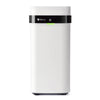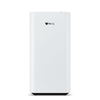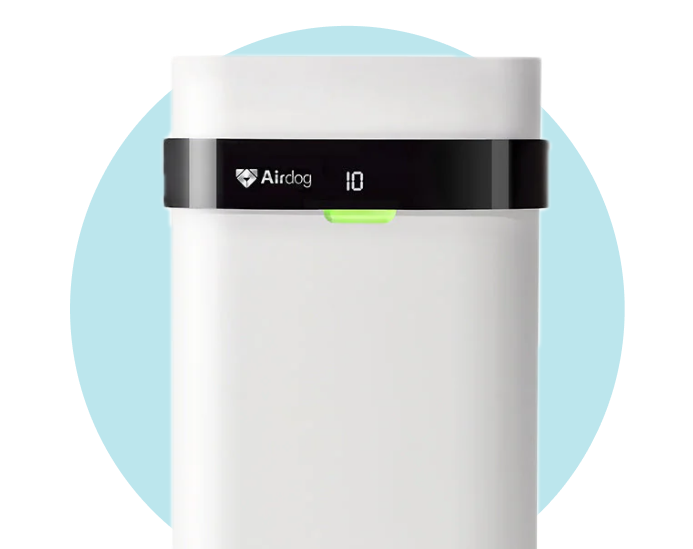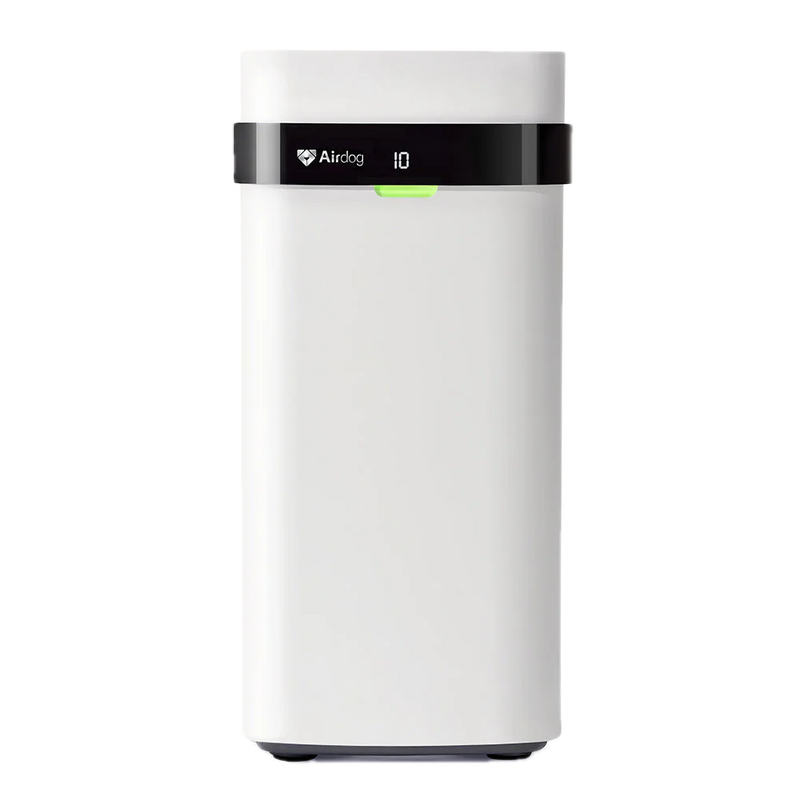Have you ever wondered just how effective an air purifier is at cleansing the air you breathe within the comforts of your home? With the average person spending approximately 90% of their time indoors, the quality of the air we breathe indoors becomes a critical aspect of our overall health and well-being.
This blog post delves into the intricate world of air purifiers, specifically focusing on their ability to significantly improve indoor air quality. We'll explore the mechanics behind air purifiers and Airdog’s filters renowned for their capacity to trap 99.97% of microscopic particles, as small as 0.00146 microns. Through reference to authoritative research, we'll provide a scientific foundation for the efficacy of air filters.
Furthermore, we'll discuss the escalating need for air purifiers in today’s households, driven by rising levels of indoor pollution and their vital role in alleviating symptoms of allergies, asthma, and enhancing overall health. How long does it take an air purifier to clean a room, and what factors influence this? Let's dive deeper into understanding the fundamentals of air purifiers to uncover these answers.
Understanding the Fundamentals of Air Purifiers
Air purifiers are silent machines working tirelessly to improve the air quality we often take for granted in our homes. But how do these devices manage this feat, and why has their presence become increasingly essential in our modern living spaces?
-
The Mechanics of Air Purifiers: At the core of most air purifiers is a filtration system designed to capture particles. These filters target pollutants like dust mites, pollen, pet dander, and smoke particles, effectively trapping them and preventing them from recirculating.
-
Scientific Backing: Studies have shown the importance of eliminating fine airborne particles to improve indoor air quality. Airdog’s technology is backed by rigorous testing, demonstrating its ability to remove pollutants like dust, pollen, pet dander, smoke, and even bacteria and viruses. By leveraging an advanced ionic field, Airdog ensures that harmful particles are not just collected but eliminated, setting a new standard in air purification.
-
The Rising Need for Air Purifiers: The demand for air purifiers has surged in response to escalating indoor pollution levels. Factors such as outdoor pollution seeping indoors, the use of chemical-based cleaners, and even our beloved pets contribute to indoor air pollution. In this context, air purifiers act as a crucial intervention, mitigating the risk of allergies, asthma, and other respiratory conditions.
-
A Healthier Indoor Environment: Beyond just trapping pollutants, air purifiers contribute to a healthier living environment. They play a pivotal role in reducing the prevalence of airborne diseases, improving cardiovascular health, and enhancing the overall quality of life for individuals and families alike.
Understanding these fundamentals equips us with the knowledge to make informed decisions about our indoor air quality. What considerations should we keep in mind when choosing an air purifier, and how can we maximize its benefits for our health and well-being? Let's continue our exploration.
Factors Influencing Cleaning Time
When pondering the question, "how long does it take an air purifier to clean a room?", it's imperative to consider several critical factors. These elements collectively determine the efficiency and speed at which an air purifier can purify the air within a specific space. Understanding these factors helps in selecting the right air purifier and in optimizing its performance for a healthier indoor environment.
Room Size and CADR
-
Room Size: The size of the room plays a pivotal role in the cleaning efficiency of an air purifier. A larger room requires an air purifier with a higher capacity to circulate and filter the air effectively.
-
Clean Air Delivery Rate (CADR): CADR signifies how well an air purifier can clean the air of specific pollutants, measured in cubic feet per minute (CFM). The higher the CADR, the more efficient the air purifier is in filtering out pollutants from a larger area.
-
Optimal Performance: Matching the air purifier’s CADR with the room dimensions ensures optimal performance. An undersized purifier for a large room will result in slower cleaning times and possibly incomplete filtration.
Air Change Per Hour (ACH) Rates
-
Definition: ACH rates indicate the number of times an air purifier can filter the total volume of air in a room within an hour. Higher ACH rates translate to more frequent air exchanges and quicker purification.
-
Impact on Health: Studies show that higher ACH rates can significantly reduce indoor particle concentrations, thus lowering the risk of respiratory issues and improving overall health.
-
Personalizing ACH: Considering personal needs, such as allergy sensitivities, can guide the choice of ACH rates, ensuring that the air purifier meets the specific health requirements of a household.
Air Purifier Placement and Pollutant Levels
-
Strategic Placement: The effectiveness of an air purifier also depends on its placement. Central locations away from obstructions allow for unrestricted air flow and more efficient room coverage.
-
Pollutant Levels: High levels of pollutants or a significant presence of specific contaminants, like pet dander or smoke, may necessitate air purifiers with specialized filters or higher CADR and ACH rates.
Real-World Purification Times
-
Variability in Times: Depending on the factors mentioned, air purification can take from a few minutes to several hours. For instance, removing smoke after cooking might take less time compared to reducing high pollen levels during the spring season.
-
Scientific Studies: Research highlighted points to significant variability in purification efficiency. For example, one study observed that while some purifiers could reduce specific pollutant concentrations by up to 50% within an hour, others took longer to achieve similar results, especially in larger or more polluted spaces.
-
Consumer Reports: Real-life tests and consumer experiences further validate that the time required for noticeable air quality improvement can vary. Some users report immediate relief from symptoms like sneezing or coughing, while others note gradual improvements over several hours.
Factors Influencing Purification Speed
-
Initial Pollution Levels: Higher levels of pollutants naturally extend the purification process. An air purifier works faster in maintaining clean air rather than initially purifying a highly contaminated environment.
-
Filter Efficiency: Traditional filters can become clogged over time, reducing efficiency and requiring frequent replacements. Airdog’s washable, reusable filters eliminate the hassle and cost of replacements while ensuring consistent, high-performance air purification. Regular cleaning keeps the system running optimally, allowing for faster and more effective purification.
Given these variables, it's clear that the question, "How long does it take an air purifier to clean a room?" lacks a one-size-fits-all answer. Room size, CADR, ACH rates, initial pollutant levels, and even the type and condition of the air purifier's filter play critical roles in determining the timeframe for air purification. By considering these factors, users can set realistic expectations and optimize their air purifiers for the best possible indoor air quality improvements.
Maximizing Air Purifier Efficiency
Ensuring your air purifier operates at peak efficiency not only contributes to a healthier indoor environment but can also significantly reduce the time it takes to clean a room of airborne pollutants. Here are actionable strategies tailored for homeowners eager to enhance their air purifier's performance.
Optimal Placement Strategies
Positioning your air purifier correctly plays a critical role in its efficiency. Here are some tips to ensure optimal placement:
-
Central Location: Place the purifier in a central spot in the room for even distribution of clean air.
-
Elevated Position: An elevated position, such as on a table, often ensures better air flow into the purifier.
-
Avoid Corners: Keeping the unit out of corners and away from furniture allows for unrestricted air intake and output.
-
Proximity to Pollutants: If possible, position the purifier closer to known sources of pollution or allergens, such as pet beds or cooking areas.
Regular Maintenance Tips
Maintaining your air purifier is essential for its effectiveness and longevity:
-
Filter Cleaning: Unlike traditional purifiers that require frequent filter replacements, Airdog’s filters are washable and reusable. Simply rinse and dry them as recommended to maintain peak performance and ensure long-term efficiency.
-
Sensor Cleaning: If your purifier has sensors, keep them clean to ensure accurate air quality readings and optimal operation.
-
Exterior Cleaning: Regularly wipe down the exterior of the purifier to prevent dust from entering the system.
Importance of Sealed Environments
During purification, it's crucial to minimize external air flow into the room:
-
Close Doors and Windows: This practice prevents the influx of outdoor pollutants and allows the purifier to efficiently clean the indoor air.
-
Use Draft Excluders: To further seal the room, consider using draft excluders on doors.
CADR Ratings and Room Size
Selecting the right air purifier based on room size and CADR ratings ensures efficient operation:
-
Higher CADR for Larger Rooms: A purifier with a higher CADR rating is more effective in larger spaces, cleaning the air more quickly.
-
Match Purifier to Room Size: Always choose a purifier with a recommended coverage area that matches or exceeds the size of your room.
Using Multiple Units in Open-Concept Homes
For homes with open floor plans, a single unit may not suffice:
-
Strategic Placement: Position multiple units throughout the space to ensure comprehensive coverage.
-
Different Models for Different Areas: Consider different models for varying needs, such as a higher CADR unit for the main living area and smaller units for bedrooms.
Innovative Features for Enhanced Efficiency
Modern air purifiers come equipped with features that can significantly boost their purification efficiency:
-
Smart Sensors: Sensors that detect pollutant levels can adjust the purifier's speed automatically, ensuring optimal performance without manual adjustment.
-
Automatic Mode Adjustments: Some purifiers can switch modes based on air quality, time of day, or presence in the room, optimizing energy use and filter life.
-
Remote Control and Monitoring: The ability to monitor and control your air purifier remotely can help you ensure it's always operating efficiently, even when you're not home.
By implementing these strategies, homeowners can enhance their air purifier's efficiency, ensuring quicker and more effective purification. Regular maintenance, strategic placement, and the utilization of modern features all contribute to creating a healthier and cleaner indoor environment.
Health Benefits and Considerations
The decision to incorporate an air purifier into your home is often driven by the desire to improve indoor air quality for health reasons. Scientific evidence and expert opinions underline the importance of selecting the right air purifier to achieve these health benefits effectively.
Reducing Allergy and Asthma Triggers
Expert Insights:
-
According to the American College of Allergy, Asthma & Immunology (ACAAI), air purifiers play a crucial role in reducing airborne allergens.
-
Air filters are adept at capturing particles such as pollen, pet dander, and dust mites, which are common triggers for allergies and asthma.
Real-World Impact:
-
Individuals with asthma or severe allergies may notice a significant reduction in their symptoms when using an air purifier consistently.
-
Regular use in environments where allergens are prevalent can lead to fewer allergic reactions and asthma flare-ups.
Lowering Risk of Airborne Diseases
Scientific Evidence:
-
Research highlighted shows that air purifiers can decrease indoor fine particle concentrations by 60%, potentially lowering the risk of diseases transmitted through the air, such as the flu or common cold.
Cardiovascular Health:
-
The same study observed a notable decrease in C-reactive protein levels, suggesting an improvement in cardiovascular health due to reduced exposure to fine particulate matter.
Unrealistic Expectations and Choosing the Right Purifier
Setting Realistic Goals:
-
While air purifiers offer numerous health benefits, it's crucial to manage expectations. For instance, they are not a cure-all solution for eliminating all indoor pollutants.
-
Effectiveness varies based on factors like room size, the specific purifier's capabilities, and the types of pollutants present.
Selecting the Appropriate Device:
-
Match the Purifier to Your Specific Needs: Consider the main types of pollutants in your home. Different filters target different contaminants.
-
Consider Room Size: Ensure the air purifier's capacity matches the size of the room where it will be used to ensure optimal air cleaning.
-
Maintenance Requirements: Be aware of the maintenance needs, including regular filter replacements, to maintain the purifier's effectiveness over time.
In embracing air purifiers as a tool to improve indoor air quality, the emphasis should always be on informed choice and realistic expectations. Whether aiming to alleviate the symptoms of asthma and allergies, reduce the risk of airborne diseases, or improve overall health, selecting the right air purifier based on specific needs and maintaining it properly are key steps toward achieving these health benefits.
Conclusion
The time it takes for an air purifier to clean a room depends on several factors, including room size, initial air quality, and filtration efficiency. While traditional purifiers rely on disposable HEPA filters that can clog and slow down over time, Airdog’s advanced TPA® technology ensures a faster and more effective purification process. With its washable, reusable filters and ability to eliminate particles as small as 0.0146 microns, Airdog provides a long-lasting, eco-friendly solution for maintaining clean air.
Investing in the right air purifier means more than just improving air quality—it’s about creating a healthier, more comfortable living environment. With Airdog, you get cutting-edge technology designed to work smarter and more efficiently, so you can breathe easier every day.
Ready to experience the difference? Explore Airdog’s innovative air purifiers and take the first step toward cleaner, healthier air today!





